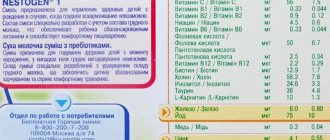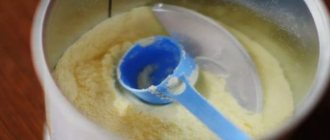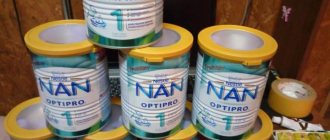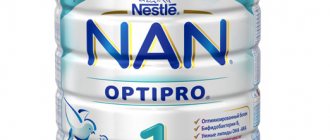Of course, there is no better product for feeding infants than mother's milk, but sometimes you have to use artificial formula . The reason may be the health status of both the baby and the mother; sometimes the loss of maternal nutrition is caused by poor ecology and the modern rhythm of life.
In such circumstances, the solution is to use “Malyutka” infant formula, which is available in 4 varieties, to feed babies up to three years of age.
Composition of Malyutka
The “Malyutka” line of milk formulas is produced by Nutricia LLC. The Dutch company has been around for over 100 years and is a leader in the baby food market.
Nutricia is represented in more than 130 countries around the world, is part of the group, the company came to Russia in 1994 and is located in Istra, Moscow region.
The mixture was developed according to the latest medical research and complies with Russian and international standards. All Malyutka components are supplied from European countries and are certified.
The mixture has good taste and smell, children eat it willingly. “Baby 1” is designed to feed children from birth to six months of age, then you should move on to other varieties (“Baby 2” and subsequent ones).
The mixture consists of:
- whey powder (source of lactose carbohydrate);
- whey protein concentrate;
- oil palm oil (closest to the fats of mother's milk due to the presence of palmitic acid);
- rapeseed, coconut and sunflower oils;
- oils of single-celled fungi Mortierella alpina (a source of arachidonic acid from the omega-6 family);
- skim milk and maltodextrin (a source of carbohydrates, an easily digestible starch substitute).
Vitamin and mineral complexes, fish oil are added to the mixture , as well as inositol, nucleotides, choline, taurine, soy lecithin and L-tryptophan in the required dosages.
“Baby 1” contains a sufficient amount of fatty acids of the Omega-3 and Omega-6 , necessary for the normal development of the brain and nervous system, and with a recent change in the composition - GOS/FOS prebiotics (galacto-oligosugars, fructo-oligosugars).
These prebiotics are similar in fiber structure to prebiotics in human milk, which promotes the development of healthy intestinal microflora in infants and ensures the absence of colic and constipation.
The ratio between the components is optimal, the mixture dissolves perfectly, and accordingly, the nipple is not clogged with undissolved lumps of the mixture.
How to properly prepare baby formula “Malyutka 1”
There is nothing difficult about learning how to dilute formula. A little patience and practice and you will learn how to make food quickly and tasty. It is important to follow the following rules:
1. Utensils for milk must be not just clean, but sterile. Immediately before diluting the product, pour boiling water over the containers. As for the mixture itself, the pack of “Malyutka” should be carefully closed after each use.
2. Prepare the water - boil and cool to 40 °C. Take the powder at the rate of: 1 measuring spoon (available in each pack) per 30 ml of water.
3. Have you prepared everything? Now proceed directly to the preparation: pour water into a sterilized bottle (control the amount of water using the scale on the bottle) - if you first put the powder in the container, you will not be able to measure the exact amount of water later. Then pour in the pre-calculated amount of product.
4. Close the bottle and shake it, stir so that there are no lumps left in the container.
5. Now make sure that the mixture is not too hot and the baby will not get burned. Drop a little diluted milk on your wrist; if its temperature is too high, you will feel it.
ATTENTION: Do not heat diluted milk in the microwave as lumps may form in it. It is also forbidden to add dry powder to already prepared milk - this will upset the proportions and can lead to negative reactions in the baby. Also, you cannot store ready-made milk “Malyutka” for more than twenty minutes.
Another important point. Many mothers who feed their children with artificial formulas are interested in how many times a day should they give their child diluted milk? If with breastfeeding many pediatricians recommend giving breasts on demand, then in the case of store-bought formulas, you should adhere to certain standards:
- up to two weeks, the child should be given 6-7 servings, consisting of three measuring spoons of powder and 90 ml of water;
- at the age of three weeks to two months, the amount of milk increases: the child receives the same 6-7 meals, but four measuring spoons each (with 120 ml of water);
- at two to three months, the baby will be full if he is fed six times a day, offering a bottle containing five scoops of “Baby 1”;
- from three to four months, the number of feedings is reduced to 5 times a day, while six scoops of product are placed in the bottle;
- Five-month-old babies eat 4-5 times a day. Place seven spoons of powder in a bottle and dilute with 210 ml of water;
- From six months, complementary foods can be gradually introduced. Due to this, the number of feedings can be reduced to 3-4 times a day.
Who is it suitable for?
Unlike products from other manufacturers, this product does not contain preservatives or coloring additives, sugar or synthetic additives.
The presence of small amounts of gluten, a wheat protein, cannot be ruled out. The mixture is fresh and does not contain lactic acid bacteria, which eliminates regurgitation.
Sometimes children are allergic to other formulas, then there is no alternative to “Malyutka”. Before using any breast milk substitute, you should first consult your pediatrician .
The mixture is packaged in rectangular cardboard boxes containing 350 and 700 g of product. The retail price of the Malyutka mixture for 1 small package is 200-250 rubles, large 350-450 rubles. Each variety of “Baby” is designed for a specific age category of infants, and a child should not be transferred to the next variety before he reaches the prescribed age.
It is recommended to store the dry mixture at a temperature from 0 to 25 ° C and air humidity not higher than 75%, but not in the refrigerator. Opened packaging should not be stored for more than 3 weeks.
Feeding chart for baby up to 6 months
Let’s look at how to feed “Malyutka” formula to children from 0 to 6 months.
Important! Do not heat food in a microwave oven as lumps may form. You should also not add powder to already prepared milk.
| Baby's age | How many times a day should you feed your baby? | Mixture norm for 1 meal (measuring spoons) | Water requirement for 1 meal (ml) |
| 0-14 days | 6-7 | 3 | 90 |
| 3-8 weeks | 6-7 | 4 | 120 |
| 2 months | 6 | 5 | 150 |
| 3-4 months | 5 | 6 | 180 |
| 5 months | 4-5 | 7 | 210 |
| 6 months | 3-4 | 7 | 210 |
How to dilute the mixture correctly?
Prepared liquid nutrition is not designed for storage; it should be prepared just before feeding the baby. Everything needed to prepare the finished mixture is given in the feeding table:
The sequence for preparing the mixture is given on the cardboard packaging. First of all, practice and learn how to determine the temperature of the water and the finished drink by dropping a few drops on your wrist, it’s not difficult.
The mixture is prepared as follows:
- With clean hands, wash the pacifier and bottle and pour boiling water over them;
- wait until the freshly boiled water cools to 40 °C;
- measure the water according to the feeding chart and pour it into the bottle;
- pour the amount of dry mixture measured with the included measuring spoon into the water, then remove the excess mixture over the spoon;
- Screw the cap onto the bottle and shake the contents until completely dissolved;
- unscrew the cap from the bottle and screw on the nipple;
- Check the temperature of the finished mixture, it should be 37 °C. The mixture is ready.
After feeding, you should immediately wash the bottle and nipple to prevent the liquid formula from drying out. This does not exclude thorough sterilization before the next feeding.
Under no circumstances should you feed your baby any leftover formula from a previous feeding. Also, do not heat the cooled mixture in a microwave oven.
How to switch to "Malyutka"
Many mothers are interested in the issue of switching to “Malyutka”. Let's look at how to do it correctly.
- The transition should be gradual. Since formulas have different compositions, taking a new food can cause stress in the child's body. The porridge should be introduced in stages, starting with 1 time per day. Then start giving your baby food 2 times a day, and then replace half the daily intake with “Malyutka”.
- The first feeding is best done before lunch, and it is important to observe how your baby reacts to new food. If a rash or other negative reactions do not appear after feeding, you can begin the transition.
- The mixture that you fed the baby earlier and “Baby 1” should be diluted in different containers.
Reviews of “Baby 1”: pros and cons
After carefully studying the official website of “Nutrition” and after reading reviews about the “Malyutka” mixture, it is very easy to compile a long list of undeniable advantages of this product:
- affordable price. Not all Russian families have enough income to buy expensive luxury milk formulas. In its price category, “Baby 1” occupies the highest positions, as it can boast not only of low cost, but also of impeccable quality - in its composition it is closest to breast milk;
- balanced composition. not only produces infant formula, but also actively works in the field of healthy nutrition and conducts various research. The results of the latest work are reflected in the company's products;
- rich vitamin and mineral composition. The balanced composition of “Malyutka” includes sixteen essential vitamins and more than a dozen useful minerals - everything that a newborn’s body requires during this period of its development. For example, the polyunsaturated fatty acids that make up Malyutka for newborns contribute to the active development of the baby’s brain and nervous system;
- normalizes the child's stool. If the “Malyutka” mixture is suitable for your baby, you can count on the normalization of the gastrointestinal tract. Also for babies with disorders of the gastrointestinal tract, it offers fermented milk mixture “Malyutka 1”;
- Suitable as a supplement to breast milk. “Malyutka” can be an excellent independent option for feeding a baby, or it can be used as additional nutrition - for example, if mother’s milk is not enough to feed the baby, or it is not saturated. “Baby” will also help out in cases where the mother is sick or has been away for a long time on her own business, for example, at work;
- Unique packaging preserves all nutrients. Close the package tightly after each use, and be sure that all the beneficial substances in it will remain for the period specified by the manufacturer. Do not use the product after the time specified by the manufacturer has expired;
- You can prepare healthy homemade desserts based on Malyutka. Don't rush to give up powdered milk when your child turns two years old. Based on it, you can prepare excellent desserts that will be not only tasty, but also healthy, due to the microelements, minerals and vitamins contained in the powder;
- good solubility, no sediment, measuring spoon. Even when you first get acquainted with the Malyutka mixture and prepare it for the first time, no problems will arise: just follow the instructions exactly. Use sterile containers, boiled water cooled to 40 °C, a measuring spoon to determine the required amount of powder - you will succeed.
If we talk about controversial issues, it is worth noting the presence of a small amount of palm oil in the formula for artificial feeding “Malyutka”. In fact, palm oil is an important ingredient that is easily and quickly absorbed by newborns: thanks to palm oil, the fat component of “Malyutki” is closest to the fat composition of a woman’s milk. Palm oil also contains unique palmitic acid, which is responsible for supplying energy to the child’s body. The legislation of the Russian Federation allows the use of palm oil in the manufacture of artificial formulas for babies. In addition, it should be noted that the Nutricia Corporation subjects the oil to multi-stage purification and adds it in strictly regulated quantities.
Finally, you need to understand that each baby is individual, and what suits one child may not suit another. History knows examples when the “Baby 1” milk formula caused a rash or, for example, constipation in a child. But there are thousands of times more cases when “Malyutka” became an excellent alternative to more expensive formulas, saturating the child’s body with all the necessary substances and microelements, and at the same time did not require exorbitant financial expenses from the family.
Found a violation? Report content











